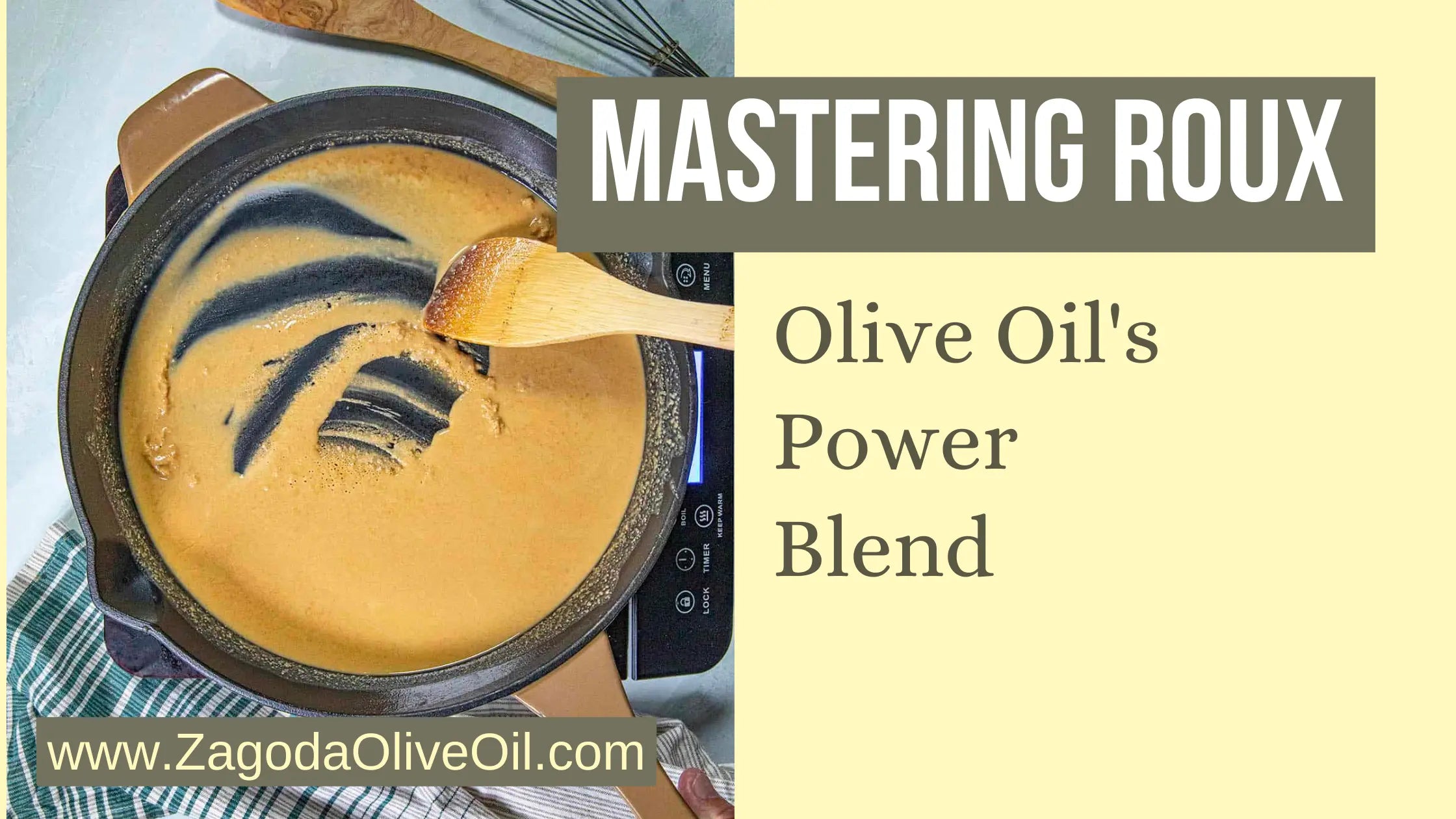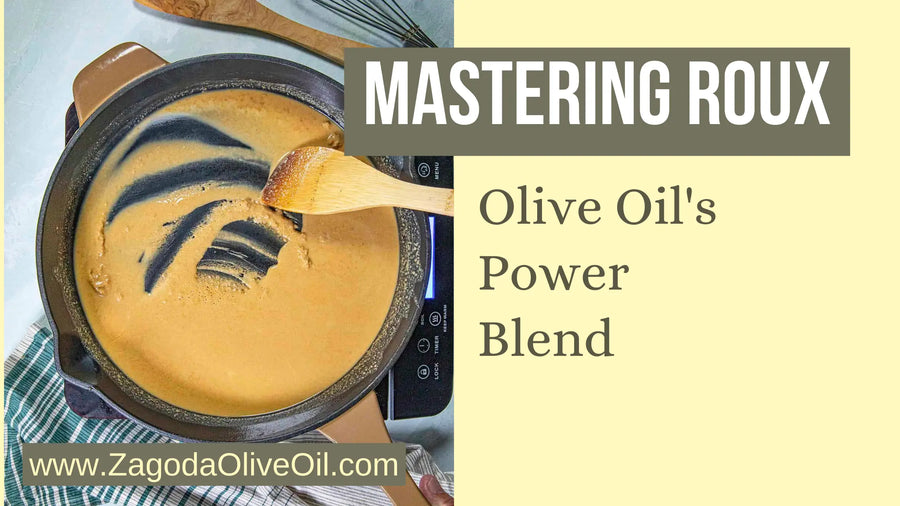A roux, traditionally a blend of flour and fat, serves as a cornerstone for thickening sauces, soups, and gravies, offering texture and flavor to countless dishes. While butter has long been a staple in roux-making, the question emerges:
Can you use olive oil to make a roux?
Indeed, olive oil, recognized for its health benefits and versatility, stands as an excellent alternative, providing a lighter, albeit equally effective, base for your culinary creations. This exploration delves into roux's fundamentals, spotlighting olive oil's pivotal role and unraveling the nuances of creating an olive oil-based roux.
Embarking on this culinary journey, you'll uncover the optimal olive oil roux ratio, understand the significance of the oil to flour ratio for a seamless roux creation, and learn how to make a roux with oil instead of butter.
From addressing whether you can make a roux with olive oil or even extra virgin olive oil to navigating common challenges and creative applications in dishes like gumbo, this article assures to equip you with the knowledge to master the art of olive oil roux.
Transform your roux-making with olive oil: a healthier, equally effective alternative to butter. Experience lighter textures, enhanced flavors, and nutritional benefits. Buy now!
Understanding Roux
A roux, at its core, is a simple yet transformative mixture of flour and fat, skillfully combined to thicken and enrich sauces, soups, and stews. The process begins by melting your chosen fat in a pan—be it butter, oil, or any fat substitute.
Once melted, flour is added to the mix, and this is where the magic starts. The key to a successful roux lies in constant stirring, ensuring an even cook and preventing any burning, which can lead to a bitter taste.
Types of Roux:
- White Roux: Cooked for about 30 seconds to 1 minute, used in sauces like béchamel.
- Blond Roux: Cooked for about 5 minutes until it takes on a light, tan color, perfect for lighter stews and
- Brown Roux: Cooked for up to 30 minutes, achieving a rich, deep color and flavor, ideal for gumbo and darker
The choice of roux color impacts not only the visual aspect of the dish but also its mouthfeel and depth of flavor. A lighter roux retains more thickening power but less flavor, while a darker roux offers a complex, nutty flavor with reduced thickening ability. The fat used in the roux, from butter to olive oil, can also influence the dish's final taste, making the selection of fat a crucial step in aligning with your culinary goals.
The Benefits of Olive Oil in Roux
Exploring the multifaceted benefits of utilizing olive oil in roux preparation reveals a harmonious blend of health, taste, and versatility that can elevate various dishes. Here are the key benefits:
- Healthier Alternative: Olive oil is celebrated for its rich content of monounsaturated fats, making it a healthier substitute for butter. This swap not only caters to those seeking dairy-free options but also to individuals adhering to keto-friendly The use of olive oil reduces butter intake without compromising on the creamy texture desired in many recipes.
- Flavor and Smoke Point: The distinct flavor profile of olive oil adds an extra layer of taste to dishes, enhancing overall culinary experiences. Furthermore, its higher smoke point compared to butter minimizes the risk of burning, ensuring a smoother cooking
- Versatility and Cost-Effectiveness: Olive oil's application extends beyond traditional recipes, offering an Italian twist to classic French sauces and making it suitable for Mediterranean Additionally, its equal parts flour and oil ratio, coupled with the requirement for whisking, presents a cost-effective and straightforward method for thickening sauces, soups, and gravies. This approach not only simplifies the
roux-making process but also ensures a pleasant aroma and texture, making it a preferred choice for both novice and seasoned cooks.
Selecting the Right Olive Oil
When choosing olive oil for your roux, particularly for dishes like mac and cheese where the flavor of the oil can shine, extra-virgin olive oil (EVOO) is your best bet. Its robust flavor and health benefits make it a superior choice. However, it's crucial to understand the nuances of olive oil types and their best uses:
- Extra-Virgin Olive Oil (EVOO): Ideal for raw applications or as a finishing oil to maintain its flavor and health benefits. Look for "First or Cold Pressed" and "Estate-Made" labels for quality
- Storage: Opt for olive oils in dark bottles or tins and store them in a cool, dark place to protect against light and heat
- Lower-Quality Olive Oils (Pure Olive Oil and Pomace Olive Oil): These are more suited for high-heat cooking like frying due to their lower quality and less pronounced
- Usage: Not recommended for gumbo roux due to low smoke points and strong flavors that may overpower the
Understanding these distinctions ensures that you select the right olive oil for your cooking needs, balancing flavor, health benefits, and cooking applications for the best culinary results.
Step-by-Step Guide to Making Olive Oil-Based Roux
To embark on making a classic olive oil-based roux, follow these straightforward steps, ensuring a perfect blend each time:
Preparation:
- Heat 1 cup of extra virgin olive oil in a heavy-bottomed saucepan over medium-low A cast-iron skillet works well for even heat distribution.
- Monitor the oil's temperature to avoid Olive oil should be warm but not smoking.
- Mixing:
- Slowly whisk in 1 3/4 cups of flour into the warm olive The key here is to add flour gradually to prevent clumping and ensure a smooth mixture.
- Continue to whisk the mixture Consistent stirring is crucial to prevent the roux from burning and sticking to the bottom of the pan.
- Cooking to Perfection:
- Keep the heat at medium-low and stir This might lengthen the cooking time but is essential to achieve the desired consistency and color without burning.
- Aim for a warm copper color for your This usually indicates that the roux is cooked through and ready for use.
- Once the desired color is reached, remove the saucepan from heat, pour the roux into a metal container, and let it cool before
Storage Tips:
- Store the cooled roux in an airtight container in the It can last for weeks, making it a handy thickening agent for future recipes.
- Before using, stir the roux well as the flour tends to separate from the oil during
Usage:
- Always add cold or room temperature roux to an already hot soup or This helps in avoiding clumps and ensures a smooth blend.
By adhering to these steps, you can master the art of making an olive oil-based roux, enriching your dishes with a healthier, flavorful thickening agent.
Troubleshooting Common Olive Oil Roux Challenges
Troubleshooting common challenges when making an olive oil roux can ensure a smooth, clump-free mixture perfect for enriching your dishes. Here are some key points to keep in mind:
- Storage and Use:
- Olive oil roux can be refrigerated in an airtight container for weeks; however, it's crucial to stir it before use as flour may separate from the
- To integrate a cold or room-temperature roux into a hot soup or sauce without clumps, gradually whisk it
- Avoiding Overcooking:
- Overcooked roux loses thickening properties and alters in flavor. To prevent this, consider mixing equal parts of flour and slightly softened butter into small balls to freeze. Each ball can thicken about a cup of liquid, offering a controlled approach to avoid
- Microwave Method:
- When making roux in the microwave, constant stirring and close monitoring in the final minutes are essential to prevent burning. Adding the trinity (onions, celery, and green bell pepper) at a critical point can halt further browning, preserving the desired flavor and
Creative Uses for Olive Oil Roux in Cooking
Olive oil roux opens a world of culinary possibilities, blending health benefits with delectable flavors across a variety of dishes. Here are some creative ways to incorporate olive oil roux into your cooking:
Sauces & Soups:
- Use olive oil roux as a thickening agent in sauces and Its ability to blend seamlessly while enhancing flavor makes it ideal for creating rich, velvety textures.
- Example: Transform your classic Béchamel sauce by using olive oil roux for a healthier, yet equally creamy
- Cajun and Creole Dishes:
- Gumbo, Jambalaya: Olive oil roux serves as the foundation, delivering depth and complexity to these traditional dishes. Its robust flavor complements the spices and ingredients used in Cajun and Creole
- Darker Roux Needs: For dishes requiring a darker roux, such as étouffée, olive oil roux provides the necessary color and flavor without the heaviness of traditional
- International Flavors:
- Provencal Cuisine: Pair olive oil roux with cooked vegetables in a gratin, embracing the Mediterranean
- Italian Dishes: Lighten up lasagna with olive oil roux, creating a less cheese-heavy but equally satisfying dish. A vegan sauce variation can be achieved by substituting vegetable stock for milk, broadening the appeal to those following plant-based
Incorporating olive oil roux not only diversifies your culinary repertoire but also aligns with healthier cooking practices, proving that flavor and well-being can coexist beautifully in the kitchen.
Conclusion
Through this culinary exploration, we have unraveled the splendid versatility and health benefits of using olive oil in making a roux, hinting at a fascinating shift from traditional butter-based methods.
The insights provided not only shed light on the practical aspects of creating an olive oil-based roux, from selecting the right type of olive oil to mastering the perfect roux ratio, but also emphasize its transformative potential in elevating dishes with a healthier, yet equally delicious, base.
The art of making olive oil roux, thus, stands as a testament to the confluence of tradition and innovation, unlocking new realms of flavor while adhering to healthier cooking practices.
As we conclude, it's clear that the incorporation of olive oil as a base for roux extends beyond mere substitution; it represents a delightful integration of global culinary wisdom, offering a pathway to enrich and diversify one's cooking repertoire.
The exploration of olive oil roux not only contributes to a more nuanced understanding of culinary fundamentals but also underscores the importance of embracing versatility in our culinary endeavors.
This journey through the intricacies of roux-making with olive oil encourages us to continue experimenting and discovering the boundless possibilities that simple ingredients, when skillfully combined, can present to both our palates and well-being.
FAQs
Can I use olive oil to prepare a roux?
Yes, olive oil can be used to create a roux, which is a combination of fat and flour used to thicken sauces and soups. While the choice of fat is up to personal preference, many recommend using high-quality ultra-premium olive oil for a delicious result.
Which oil is ideal for making a roux?
While any oil can be used for making a roux, many cooks prefer using grapeseed oil, especially for darker roux, due to its higher smoke point. This allows you to cook the roux at higher temperatures for longer periods without the risk of burning the oil.
What is the proper flour to oil proportion for a roux?
The standard ratio for creating a roux is equal parts flour to oil, typically 1:1. To make it, combine the flour and oil in a heavy-bottomed pot, such as a cast iron skillet or a Dutch oven, and stir the mixture constantly over medium-high heat with a wooden spoon until it
reaches the desired consistency and color, starting with a light shade known as a blonde roux.
Is it possible to use olive oil instead of butter in a roux?
Absolutely, olive oil can be substituted for butter in a roux. In fact, any fat can be used, including butter for its flavor or vegetable oil for neutrality. Other fats like lard, bacon grease, or schmalz are also suitable, whether they are of animal or vegetable origin.


